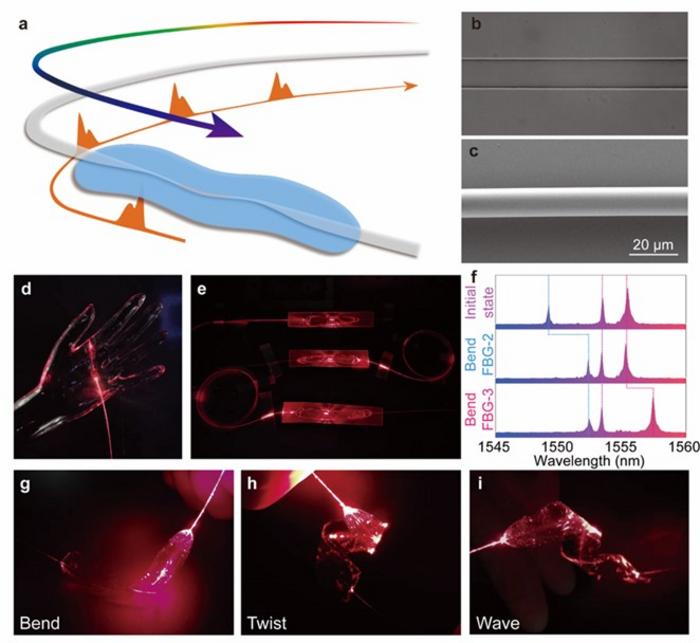Cardiovascular
Skin-Like Microfiber Grating Gauges Cardiovascular Wellness
NANJING, China, Aug. 31, 2023 — According to the World Health Organization, 17.9 million people die annually due to cardiovascular diseases. Soft wearable devices are well suited for monitoring physiological signals from electrocardiogram, phonocardiogram, and pulse wave. Advantages of these types of devices include real-time operation capability, skin-like mechanical properties, and high signal-to-noise sensing capability.
However, monolithic hemodynamic parameters achieved by current wearable devices cannot adequately and precisely reflect the health status of regional vasculature. Spatiotemporal hemodynamic monitoring techniques are needed to satisfy growing demand for clinical treatment and daily health management of the cardiovascular system.
Researchers from Nanjing University have developed a hemodynamics monitoring technique that relies on a configurable, skin-like microfiber Bragg grating group to deliver information on the real dynamics of the systemic cardiovascular system, such as heartbeat, angiectasis, and pulse wave propagation. The system overcomes common bottlenecks to biophotonic sensing mechanisms that use commercial fiber Bragg grating (FBG) devices.
Although the conventional DOF sensing technique represented by the fiber Bragg grating FBG is well suited for spatiotemporal hemodynamic monitoring, the researchers said, the traditional optical fiber commonly used in the method has a large distinct mechanical property with the skin and a low response on physiological signals. This makes it difficult to be worn on the body stably and comfortably. And, while flexible packaging technology has been used to address the mechanical mismatch, thick encapsulation and the low sensitivity of commercial FBG devices pose an obstacle in detecting subtle physiological signals, thereby limiting their potential applications in wearable devices.
Similarly, optical microfibers have been proven to have excellent flexibility, configurability, and large evanescent fields for high-sensitivity sensing. However, existing devices based on optical microfiber are difficult to achieve spatially distributed, time-synchronized, and multiparameter sensing capabilities without a wavelength encoding strategy.
A skin-like microfiber Bragg grating (μFBG) patch enables what its developers called a ‘photonic skin’ sensing network for cardiovascular health monitoring. Courtesy of Opto-Electronic Advances.
The researchers’ skin-like microfiber grating group combines ultrathin flexible packaging technology with microfiber to produce skin-like fiber patches. The researchers used femtosecond laser direct writing technology to noninvasively inscribe the Bragg gratings into the interior of the microfiber. This provided different wavelength encodings for multiple microfiber patches, which in turn enabled synchronous multichannel sensing capabilities.

By connecting microfiber grating patches in series, the researchers detected multiple physiological signals at different nodes of the human body simultaneously and distinguished them by different working wavelengths. Since the light-based physiological signals propagate at close to the speed of light in the microfiber grating group, the time synchronization is only limited by the FBG interrogator.
The researchers ultimately activated the monitoring technology by detecting the proximal ballistocardiograph signal and the distal pulse wave at each superficial artery in the human cardiovascular system and then calculating the pulse wave transmit time. By detecting mechanical signals at the proximal and distal ends of the cardiovascular system instead of electrophysiological activity signals, the monitoring technique can present the real dynamics of the systemic cardiovascular system, such as heartbeat, angiectasis, and pulse wave propagation.
In addition, the mechanism showed favorable repeatability and stability — under 10,000 stress circles.
In their development of the technique, the researchers presented three distinct hemodynamic monitoring modes. They said that the technology has the working capability of real-time and dynamic evaluation of local blood vessel health status in the whole cardiovascular system, demonstrating great potential in the diagnosis of cardiovascular diseases such as arrhythmia, angiosclerosis, hypertension, and thrombosis. Further, the advancement could serve to facilitate precise clinical diagnosis, the fast screening of lesions, and daily health management.
The research was published in Opto-Electronic Advances (www.doi.org/10.29026/oea.2023.230018).

